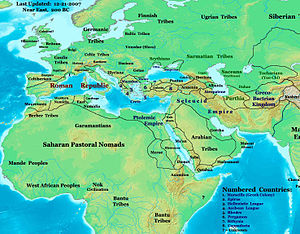- Numidians
-
The Numidians were Berber tribes who lived in Numidia, in Algeria east of Constantine and in part of Tunisia. The Numidians were one of the earliest natives to trade with the settlers of Carthage. As Carthage grew, the relationship with the Numidians blossomed. Carthage's military used the Numidian cavalry as mercenaries. Numidia provided some of the highest quality cavalry of the Second Punic War, and the Numidian cavalry played a key role in a number of battles, both early on in support of Hannibal and later in the war after switching allegiance to the Roman Republic.
The Punic Wars
During the Second Punic War, Syphax was the chief of the largest Numidian tribe, the Masaesyli. In 213 BC, Syphax ended his alliance with Carthage. In 208 BC, he rejoined after marrying Sophonisba, daughter of Hasdrubal Gisco.
Syphax tried to get Hannon Barca and Publius Cornelius Scipio to bring peace between the two nations after the Romans had landed in Africa. With the help of Masinissa, Publius Scipio's troops set fire to Syphax's camp.
Publius Scipio placed Masinissa in charge of much of Syphax's former territory in recognition for Massinissa's aid against Carthage. After the Second Punic War, Masinissa started combining the tribes. Massinissa wanted to combine the nomadic tribes into a united nation with an agricultural industry.
The peace treaty between Carthage and Rome prevented Carthage from entering any wars without Rome's permission. Masinissa exploited the treaty by taking Carthaginian land. He used various tricks to get land including stating that Carthage was rebuilding their Navy despite the treaty which prohibited a Navy. Rome continually ruled in favor of Masinissa. When Carthage asked for an appeal Cato the Elder was sent with a commission to mediate a settlement. The commission insisted that both sides agree to their final decision. Masinissa agreed but because of how unfavorable previous Roman decisions had been Carthage refused. Cato had served in the Roman Legion during the Second Punic War. Carthage's refusal to accept the commission convinced him that the Third Punic War was needed. Cato made a series of speeches to the senate all of which ended with "Ceterum censeo Carthaginem esse delendam" (Moreover, I advise that Carthage should be destroyed).[1]
A group of Carthaginian senators supported a peace treaty with the Numidians. This group was in the majority, in part because the populace of Carthage did not want to submit to a people they had traditionally dominated. The pro-Numidians were eventually exiled. Upon exile they went to Masinissa for help. Masinissa sent two (of his forty-four) sons to ask for the pro-Numidians to be let back in. Carthalo, who led a democratic group who were against the Numidian encroachment blocked their entry. Hamilcar, another leader of the same group, sent a party to attack Masinissa's sons.
Masinissa sent a force to siege the Carthaginian city of Oroscopa but they were repelled by a Carthaginian army led by a Hasdrubal. Among the captured were two of Masinissa's sons. This became the final excuse for Rome to attack Carthage.
In 149 BC, Masinissa died of old age. His death occurred during the Third Punic War. Scipio Africanus had Masinissa's territory divided between three of his sons thus preventing Masinissa's goal of a unified nation much as Alexander the Great's empire was divided upon his death.
See also
References
- Lazenby, J. F., Hannibal's War, London, 1978
- Warmington, B. H. Carthage, A History, Barnes and Noble Books, 1993
Categories:- History of Numidia
- Berber groups
- Ancient Algeria
- Ancient Tunisia
- Ancient peoples
Wikimedia Foundation. 2010.

